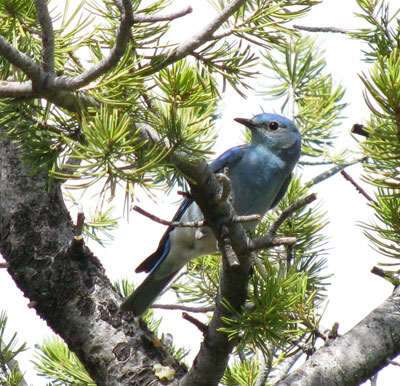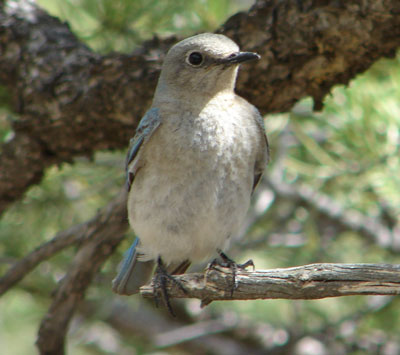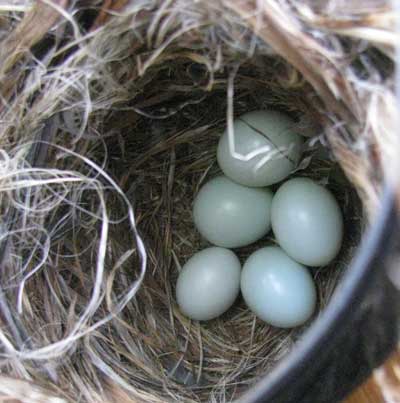Contents: Species, Interesting Facts, Identification, Song, Distribution, Preferred Nesting Habitat, Diet, Nesting Behavior, Nestboxes, Nestbox Location, Recommended Distance Between Nestboxes, Monitoring, Nesting Timetable, Longevity, More Info. Also see photos of nests, eggs and young.
Note: If you have Mountain Bluebirds, I strongly recommend Myrna Pearman’s book, Mountain Bluebird Trail Monitoring Guide (available from NABS), which is the source of much of the species-specific information below.



Species: There are three bluebird species: Eastern (Sialia sialis), Mountain (S. currucoides) and Western (S. mexicana.) There are no recognized subspecies of the Mountain Bluebird . (See more info and differences between species). The alpha code for the Mountain Bluebird is MOBL. It may interbreed with Eastern Bluebirds where their ranges overlap. Historically, Mountain Bluebirds were referred to as the Arctic Blue-bird (S. arctica? James Audubon)and Ultramarine Blue-Bird, and by the scientific name Erythaca Arctica? (Swains and Rich)
- The Mountain Bluebird isthe State Bird for Idaho (1931) and Nevada (1967.) MOBs have appeared on several U.S. postal stamps.
- Bluebirds checking out chimneys or vertical pipes for potential nest/roost sites often die, so it is good to screen or seal them.
- Unlike Eastern Bluebirds, they may snatch up insects in midair, and forage while hovering.
- Banding studies indicate pairs rarely last from year to year (although there have been recorded instances of pairs staying together for two years in a row. Instead, they seem to bond to the nest site. (Pearman)
- May flock with 50 to 100 birds at wintering grounds (e.g., in central Mexico) and occur in mixed-species flocks.
- May sing in flight (Power)
- Mountain bluebirds generally beat out Tree Swallows when competing for nest sites.
Identification: Adult Male is pale sky- blue, pale blue breast and flanks. May show a trace of rufous on throat and breast in fall and early spring, winter plumage is duller grayish/brownish-blue. Some males are brighter blue than others. Female is pale sky-blue (winter plumage is actually slightly brighter than breeding plumage) with a pale chin, gray/brownish back, ashy gray belly, may have rufous wash on breast in fall and early spring. Compared to Eastern Bluebirds, they are a paler blue, slimmer, longer-winged and tailed (7.5″ length, compared to 7″ length for Eastern and Western), with a thinner bill with little or no yellow at base. Their wingspan (per Sibley) is 14″, compared to 13″ for Eastern, 13.5 for Western.) Juveniles have a spotted breast, and are darker and duller than adults.
Song: Series of low, soft burry whistles or chortles. Male may warble at dawn. Call note is a soft pew. May chik or chak when disturbed, or clack their beaks.
Distribution: Nests in the foothills and mountains of western North America, from east-central Alaska, east to southwestern Manitoba and the Dakotas, south to southern California, northern Arizona, and southern New Mexico. May winter as far south as Mexico, or as far north as British Columbia. Seen above the timberline, mostly in post-breeding dispersal periods.
Preferred Nesting Habitat: Probably dry areas in open grassland habitat, such as sparsely treed savanna, pastures and grassland with short grasses and vegetation. See BBS Map.
Diet: Spiders and insects (grasshoppers, crickets, caterpillars (preferred?), beetles, moths, butterfly larvae or adults, flies, bees, dragonflies, cicadas and ants. Prey may be whacked or wings removed. During bad weather they will eat earthworms and berries (hackberry seeds, fruit of juniper, cascara, sumac, currant, elderberry, cedar, mistletoe, Virginia Creeper and grape.) Because they primarily hunt on the ground (although they will hawk or hover, especially on windy days), they prefer areas with low or sparse ground cover not taller than they are.
Nestboxes: As a secondary cavity nester, will use natural cavities, cavities created by woodpeckers, holes in sandstone cliffs or clay banks. Readily accept nestboxes. Will also nest in mailboxes, trailer hitches, under eaves of buildings, in pipes and farm implements. Mountain bluebird expert and author Myrna Pearman does not recommend PVC boxes for MOBLs, as they do not provide adequate thermal protection against spring storms or cold night-time temperatures common in MOBL nesting territory. Pearman recommends a nestbox floor size of 5×5″ inches. Mountain Bluebirds need a larger entrance hole – 1 9/16″ (Eastern or Western bluebirds 1.5″.)
Nestbox Location: Females are more likely than males to return to the same nest site (Pearman).
Recommended distance between nestboxes: 200-300 yards (NABS.) Bluebirds may nest closer to each other if foraging habitat is good, cavities are plentiful and/or they cannot see the other pair from their nest site because something (like a building) blocks their view. Power says pairs may nest 110 yards apart. On Tina Mitchell’s trail in Coaldale, CO, pairs have nested 65 and 75 feet apart (in a location where natural cavities are rare.) Territory size may be about 12 acres (Pearman), but decreases during nesting season. Adults may space themselves >1 meter apart along fences and power lines (Power) Linda Brockway spaces her boxes about 3-5 acres apart, as she has found that MOBLs seem to prefer more territory than WEBLs.
Monitoring: Fairly strong defenders of nest site. May approach when box is monitored, or divebomb from behind (Power.) Pearman recommends not opening box after nestlings are 16 days old to prevent premature fledging.
- Excavation or nest site selection: Generally migratory, may be resident. If not, arrives in early spring (February – March, depending on location), with nesting starting later in higher elevations. Males show off cavities, and the female makes the final choice. Good sign, but no guarantee, if female enters box during house hunting.
- Nest construction: 1-7 days (typically 4-7), mainly in the morning. May start in early March to late April or early May depending on location. Nest of dry grass, weed stems, pine needles, twigs, straw, rootlets, shreds of dry bark, and, sometimes, wool, hair (e.g., deer or horse), or feathers. Deep (~2 inches), well-formed cup lined with finer materials, and occasionally a few feathers or trash (shredded paper, plastic wrappers.) Built by female (although male may bring in some nesting material, especially during courtship.)
- Egg laying: Usually begins a day or two after nest is complete (depends on weather.) See typical first egg dates by State. Depending on climate, the first egg may be in late March to the first week of May. One egg is laid each day until clutch is complete – typically 5-6 for the first clutch, 4-5 for second, up to 8. Eggs are oval, smooth, glossy, unmarked, and are pale blue, bluish-white, or, rarely, white. Male sits near nest site to defend.
- Incubation 13-15 days, depending on location and temperatures. Begins with the last or second to last (penultimate) egg. Only the female incubates (since only she has a brood patch) but the male may sit on the eggs when she is out feeding. The female sleeps in the cavity during incubation, while the male roosts nearby.
- Hatching: Usually occurs over a 24 hour period. Asynchronous hatching is possible. Young are altricial (blind and naked). The female broods them intermittently for a week or longer. The female may prevent the male from feeding young while she is brooding (taking the food from him, and sometimes eating it herself.)
- Development: From hatching to day 5, young are fed soft bodied insects and larva. After that, spiders and hard-bodied insects are fed.Parents remove fecal sacs throughout nesting. For photos and detailed description of nestling development, see Pearman’s book.
- Day 1: Eyes closed, pinkish skin with sparse down. Uncoordinated, raising head weakly and unsteadily, faint vocalizations.
- Day 3: ear openings evident.
- Day 5: feather tracts are all dark. Days 5-8, eyes open.
- Day 7: feathers fully broken through all tracts except wings
- Day 12: color on wings first visible
- Day 13: Down feathers on crown stick out, no exposed skin except abdomen, may clacks. Avoid opening box after Day 13 to prevent premature fledging.
- Fledging: 17-22 days +/- depending on weather and food availability. For the first three days, they are very dependent on parents, and by about 10 days begin capturing and preparing their prey. In 3-4 weeks they are on their own. Young get their adult plumage over the summer. If the female starts another brood, the male will care for the first brood.
- Dispersal: Juveniles often remain with parents throughout summer and fall. After breeding, flocks may move to other feeding grounds, and then reappear in late summer or early fall. They leave their breeding grounds from August (Power) or September to November, depending on location. 76About 1 to 4 percent of banded nestlings return to within 15 miles of their natal grounds the following year (Pearman)
- Number of broods: Last broods are usually out of the nest by August. If the first brood is successful, about half of pairs may attempt second brood if food supply and weather are good (Power). In the southern part of their range (and recently as far north as eastern Alberta, Canada), may raise three broods. Failures of second nestings are common (40% or more?). Unsuccessful females may change territories or nestbox types between clutches. (Power)
- Longevity: Nine years is the record for banded birds. Ellis Bird Farm has recorded an 8 year old male and a 7 year old female (Pearman) See more info.
References and More Information:
- Nest and Egg ID (with links to species biology and photos of nests, eggs and young) for other small cavity nesters
- Mitchell, Tina, Sipapu and personal communications
- Pearman, Myrna, Mountain Bluebird Trail Monitoring Guide 2002
- Power, Harry W. and Michael P. Lombardo. 1996. Mountain Bluebird (Sialia currucoides), The Birds of North America Online (A. Poole, Ed.). Ithaca: Cornell Lab of Ornithology; Retrieved from the Birds of North America Online: http:// bna.birds.cornell.edu/bna/species/222 doi:10.2173/bna.222
- Sipapu, Tina Mitchell’s trail in Coaldale CO, blog
As the pressure of population increasingly regiments us and crowds us closer together, an association with the wild, winged freedom of the birds will fill an ever growing need in our lives.
– Edwin Way Teale, introduction to Songbirds in Your Garden, 1953
